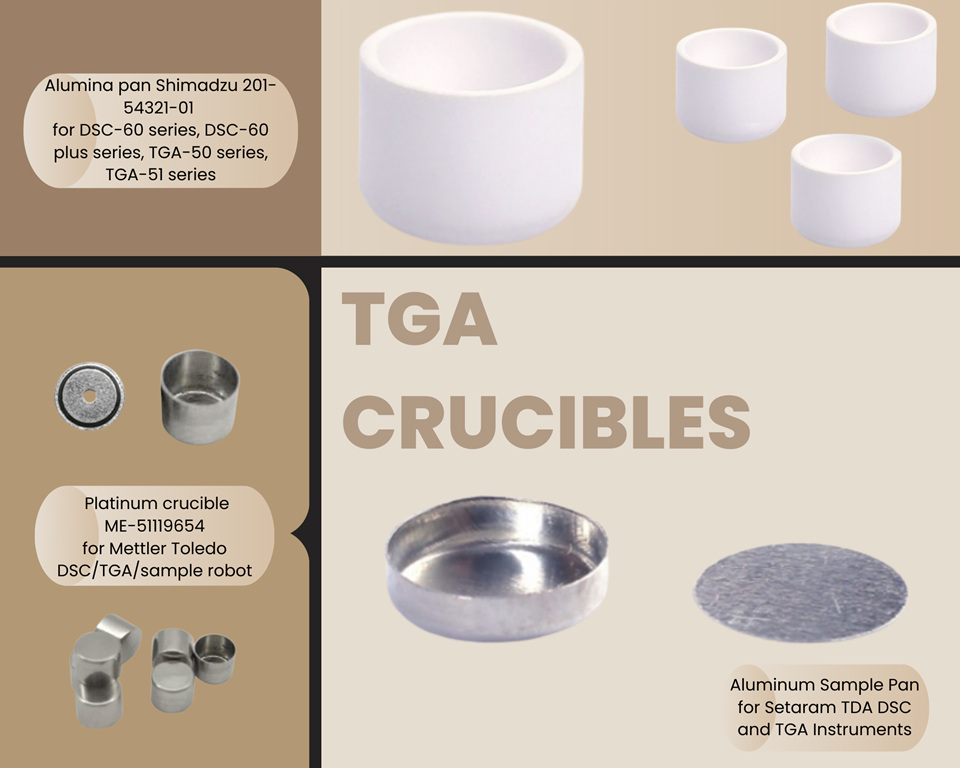Your cart is empty.
shop now
Your cart is empty.
shop now
Simultaneous thermogravimetric analysis (TGA) and differential scanning calorimetry (DSC) analysis is a powerful technique used in various fields such as materials science, chemistry, and polymers. This combined analysis provides valuable information about the thermal properties and behavior of materials. In this article, we will explore the process of performing a simultaneous TGA-DSC analysis using TGA crucibles.
TGA-DSC is a technique that combines the measurements of both mass changes (TGA) and heat flow (DSC) during a controlled heating or cooling process. It allows for the simultaneous determination of weight loss or gain and the corresponding thermal effects such as phase transitions, decomposition, and oxidation.
Simultaneous TGA-DSC analysis offers several advantages over individual TGA or DSC techniques. It provides a more comprehensive understanding of the material's behavior by correlating the weight change with the associated heat flow. This correlation enables the identification of thermal events and their corresponding mass changes, leading to a more accurate characterization of the material's properties.
TGA crucibles are small containers made of various materials that can withstand high temperatures. They hold the sample during the TGA-DSC analysis and allow for precise measurement of mass changes. Crucibles are available in different forms such as pans, cups, and capsules, depending on the sample type and analysis requirements.

Selecting the appropriate TGA crucible is crucial for obtaining reliable and accurate results. Factors to consider include the sample composition, temperature range, desired sensitivity, and compatibility with the instrument. Common crucible materials include aluminum oxide, platinum, and ceramic.
Before loading the sample, it is essential to prepare the TGA crucible properly. This involves cleaning the crucible to remove contaminants or residues that may affect the analysis. Depending on the material, cleaning methods such as acid washing or heat treatment may be required.
Proper instrument setup is vital to ensure accurate measurements. The instrument should be calibrated, and the heating, gas flow, and atmosphere settings should be optimized for the specific analysis. Calibration ensures the accuracy of weight and heat measurements, allowing for reliable data interpretation.
Once the TGA crucible is prepared and the instrument is set up, loading the sample onto the crucible is next. Care must be taken to ensure uniform and representative sample placement. The sample size should be appropriate to avoid potential overflow or insufficient coverage on the crucible.
With the sample loaded, the simultaneous TGA-DSC analysis can be initiated. The instrument applies controlled heating or cooling to the sample while measuring the associated weight change and heat flow. The analysis typically involves ramping the temperature at a constant rate and monitoring the resulting thermograms.
Interpreting the TGA-DSC results involves analyzing the obtained thermograms. Peaks or deviations in the curves represent thermal events such as phase transitions, decomposition, or reactions. The weight change data and the corresponding heat flow information provide insights into the material's thermal stability, composition, and kinetics.
Simultaneous TGA-DSC analysis finds applications in various fields. It is used for studying polymers, composites, catalysts, pharmaceuticals, and other materials. The technique enables the characterization of thermal behavior, thermal stability, degradation kinetics, and the determination of thermal properties such as specific heat capacity and enthalpy.
Simultaneous TGA-DSC analysis offers several advantages, including the ability to correlate weight changes with thermal effects, providing comprehensive information about material behavior. It also allows for the determination of specific heat capacity and enthalpy, which are essential for material design and process optimization. However, limitations include the potential interference between TGA and DSC signals and the complexity of data interpretation.
During simultaneous TGA-DSC analysis, certain issues may arise. Common problems include baseline drift, crucible deformation, instrument malfunctions, and incorrect sample preparation. Proper troubleshooting techniques involve investigating possible causes, optimizing instrument settings, and ensuring sample integrity.
When performing simultaneous TGA-DSC analysis, it is important to adhere to safety precautions. This includes wearing appropriate personal protective equipment (PPE), working in a well-ventilated area, and following the manufacturer's guidelines for handling high-temperature equipment and potentially hazardous samples.
Simultaneous TGA-DSC analysis using TGA crucibles is a valuable technique for understanding the thermal properties and behavior of materials. Correlating weight changes with thermal effects provides comprehensive insights into material composition, thermal stability, and degradation kinetics. Proper instrument setup, sample preparation, and data interpretation are essential for obtaining reliable results.
1. Can I reuse TGA crucibles for multiple analyses?
- TGA crucibles can often be reused after proper cleaning and inspection. However, some samples may leave residues that can contaminate subsequent analyses, requiring new crucibles.
2. What is the significance of the heating rate in simultaneous TGA-DSC analysis?
- The heating rate determines the speed at which the sample temperature increases. It affects the kinetics of thermal events and can influence the observed weight loss and heat flow behavior.
3. Can simultaneous TGA-DSC analysis be performed under different gas atmospheres?
- Yes, simultaneous TGA-DSC instruments can be operated under different gas atmospheres such as air, nitrogen, or inert gases, depending on the analysis requirements and sample compatibility.
4. What are the main differences between TGA and DSC techniques?
- TGA measures the weight change of a sample as a function of temperature, while DSC measures the heat flow associated with thermal events. Simultaneous TGA-DSC combines both techniques for comprehensive analysis.
5. How can I troubleshoot baseline drift in TGA-DSC analysis?
- Baseline drift can be caused by instrument instability or contamination. To troubleshoot, check instrument calibration, verify sample integrity, and ensure a clean crucible environment.